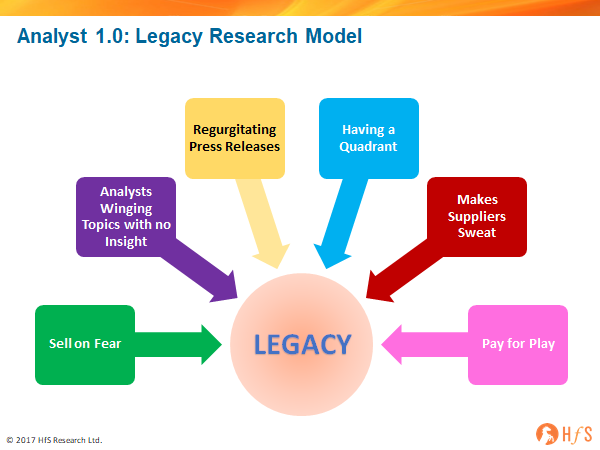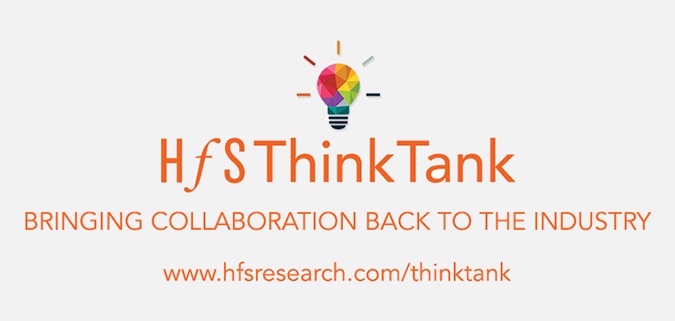It’s time to close the chapter on the legacy analyst industry that has lost its energy, its identity, its independence and sense of purpose. HfS was founded seven years ago to shake this up, and what’s astounded us is the stubborn refusal of the rest of the industry to change, preferring to milk the remnants of a stale model. So we’ve worked very hard behind the scenes to develop a knowledge platform that impacts, with an engagement style that shakes our clients from their slumbers. Welcome to our ThinkTank…
Why is the legacy analyst industry stuck in a depressing holding pattern?
The analyst industry never made it out of 1.0. Despite all the guff about analysts using twitter and blogs, the sporadic number of boutiques and one-man/woman bands that slipped in (and out) of the analyst market over the last decade. Despite the “freemium model”, where there was a pretence of free research “disrupting” the market, but most of it being regurgitated supplier press releases. We are still trapped in the old analyst model:

Let’s face it, this current model has steadily deteriorated over the last decade, with most analysts firms selling their praise to willing vendor marketeers only too happy to fund the propaganda, adding increasingly damp fuel in vein attempts to heat up their sodden sales decks and watery marketing brochures. Even firms like NelsonHall, Everest, Zinnov and others have got in on the act of putting out endless scatterplot quadrants of supplier positions in all sorts of markets – as if customers really take this stuff seriously anymore? Is this the only way these firms can forge a living these days? How can you “influence” a market when your only impact is a few thousand quasi-human twitter followers, you don’t run customer summits, you don’t provide your clients with research labs, you don’t provide relevant data products and the only people you ever talk to are suppliers?
I would even go as far as declaring some of these “analyst” firms should be more correctly reclassified as supplier marketing support firms. How can you be an “analyst” when all you do is take money from marketing people to reinforce their products?
The current model is increasingly desperate, we now see tech suppliers buying up advance licences of Quadrants, Waves and Marketscapes at the beginning of their budget cycles, before they are even written, so they can pick and choose which scatterplots to buy licenses when they like the outcome. Yes, people, this really happens.
How did it get this bad? Simple – most analyst firms are just not very good. They are jaded, they are too stingy to invest in real talent with real experience, and just reel out the same old dinosaurs whose only value to industry is to market the wares of their paying customers.
Fortunately, we have started to see light at the end of this rather dingy tunnel. Which is about time, as there’s nothing more depressing than bemoaning a stagnant industry encircling the drain before its eventual plummet into the plug hole of irrelevance.
Don’t lose hope. Analyst 2.0 is finally here!
The industry is reaching its first major Come-to-Jesus moment, where growth is flat, there is mass confusion surrounding the real impact of “disruptive digital business models”, with the potential creative destruction of automation, the lack of clarity of the business benefits of cognitive and AI, and the blurry potential of blockchain in its nascent pre-industrial form. It’s well past time for enterprise customers, suppliers and other key stakeholders to come together and really collaborate and think about what their true options are moving forward.
But, all is not lost, folks, because HfS is kick-starting a new era in the analyst biz with the HfS Impact model. Let’s be honest, the analyst 1-800 hotline market, where you have to wait 3 weeks to talk to some clueless kid, and those strategy days when you got subjected to an endless deluge of dull slides explaining the basics of your industry that you were reading about in 2003, are fizzling out. No one cares anymore. No one bloody cares.
We’ve made it our mission to drag this business kicking and screaming out of these dark ages of obsolescence. So, welcome to Analyst 2.0, a model based entirely on Knowledge and Influence, centred around our revolutionary ThinkTank:

The ThinkTank approach is all about getting the industry collaborating again, where we use Design Thinking techniques to drive joint problem-solving. Our mantra is that the analyst role is shifting from passive observer to facilitator. To make this happen, we have dedicated an entire floor of our new offices in Cambridge England, in addition to facilities in Chicago and Boston, to hosting day long ThinkTank sessions with our clients. ThinkTanks are where we invite customers, suppliers and even advisors to spend entire days with us Design Thinking their desired goals, and solving the problems that are preventing their achieving these outcomes. This is where we challenge you, you challenge us, and we work together, supported by our research, to drive genuine achievement, defining where you need to go and clearing the path to get there. And yes, we lock all our phones away in a safe, while we drive this whole ThinkTank process. Learn more about the ThinkTank.
The Bottom-line: The HfS Mission is to Revolutionize the Industry and lay the Analyst 1.0 model to rest. For good
HfS’ mission is to provide visionary insight into the major innovations impacting business operations: automation, artificial intelligence, blockchain, digital business models and smart analytics. We focus on the future of operations across key industries. We influence the strategies of enterprise customers to develop operational backbones to stay competitive and partner with capable services providers, technology suppliers, and third party advisors.
HfS is the changing face of the analyst industry combining knowledge with impact:
- ThinkTank model to collaborate with enterprise customers and other industry stakeholders.
- 3000 enterprise customer interviews annually across the Global 2000.
- A highly experienced analyst team.
- Unrivalled industry summits.
- Comprehensive data products on the future of operations and IT services across industries.
- A growing readership of over one million annually.
The “As-a-Service Economy” and “OneOffice™“ are revolutionizing the industry!
Posted in : Business Process Outsourcing (BPO), IT Outsourcing / IT Services








Loved reading this, Phil. You’re observations are spot on, and love these new solutions. Best of luck!
James
HFS has been the one breath of fresh air in the analyst business, but you are correct that the industry is still stuck in this legacy model that isn’t shifting anytime soon. Hope the ThinkTank is the gamechanger you want it to be!
Paul
Phil,
This design thinking approach to research is unique. Will be interesting how you align it to enterprise clients – can you share any techniques you’ll be trying out?
Ramesh
@Ramesh – You can use Design Thinking to understand what’s really causing problems, issues or expenses, by better understanding what people are actually doing –or not— and feeling. What is their experience? And then working through ideas that may revise, or replace, or eliminate process; that may change what people are doing and how; and could use current technology better, or new technology.
If you want your customers and your stakeholders to work with you to reach your business outcomes, then look for ways to make it easier for them to do it – and that means understanding them better, and that’s a role that Design Thinking can play:

As one shared services executive told us, “we already know how to make something efficient [with Lean Six Sigma] and we required a new way of thinking in some specific areas.” Along these lines, we are not anticipating an end or replacement to Lean Six Sigma or “operational excellence” but adding a way of stepping outside the process to identify trouble spots and new solutions.
With Design Thinking you focus on understanding who is involved in whatever process or problem you are looking to address, and what are their expectations and needs (the “human” side)? And what is the industry and corporate context, the business outcomes to impact (the “business” side)? And what are the technology enablers? Then bringing it all together in a solution through a series of prototypes and tests. Sometimes the solution is a quick fix, like changing the day of the week or where a request from a consumer is directed in a system; and sometimes it will help you identify a new way of working or a new service or solution.
PF
Great thought leadership. Will Andrew be running these in Asia?
@Adrian – Andrew’s spent the last two decades in legacy analyst firms and hasn’t had any real industry experience, so it’ll likely take a while for him to break out of that mindset. We’re hopeful he’ll eventually make the breakthrough as he immerses himself with such forward-thinking and innovative people out there =)
PF